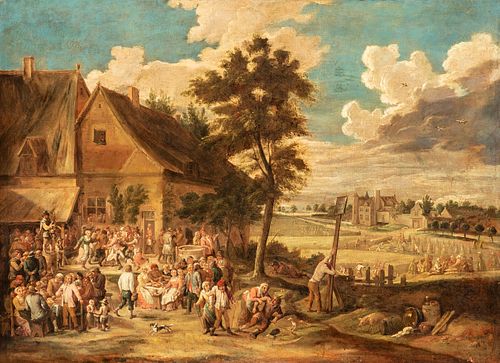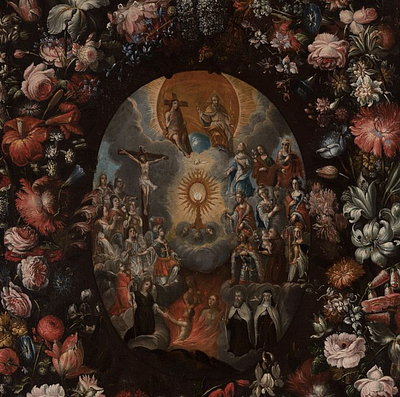Spanish school of the second half of the 19th century, following models of DAVID TENIERS II THE YOUNG (Antwerp, 1610 - Brussels, 1690). "Kermesse (Fes
Lot 81
About Seller
Setdart Auction House
Carrer Aragó 346
Barcelona
Spain
Setdart Subastas was born in 2004 and is currently the first online art auction in Spain with solidity, prestige and reliability guaranteed by our more than 60,000 users. Setdart has a young, dynamic and enterprising team ready to successfully manage the purchase and sale of art works through custom...Read more
Estimate:
EUR€15,000 - EUR€18,000
$16,129.03 - $19,354.84
Absentee vs Live bid
Two ways to bid:
- Leave a max absentee bid and the platform will bid on your behalf up to your maximum bid during the live auction.
- Bid live during the auction and your bids will be submitted real-time to the auctioneer.
Bid Increments
| Price | Bid Increment |
|---|---|
| EUR€0 | EUR€10 |
| EUR€200 | EUR€25 |
| EUR€500 | EUR€50 |
| EUR€1,000 | EUR€100 |
| EUR€3,000 | EUR€200 |
| EUR€5,000 | EUR€500 |
| EUR€10,000 | EUR€1,000 |
| EUR€20,000 | EUR€2,000 |
| EUR€50,000 | EUR€5,000 |
About Auction
By Setdart Auction House
Jul 14, 2021
Set Reminder
2021-07-14 06:30:00
2021-07-14 06:30:00
America/New_York
Bidsquare
Bidsquare : OLD MASTERS
https://www.bidsquare.com/auctions/setdart-auction-house/old-masters-7202
Setdart Auction House sofia@setdart.com
Setdart Auction House sofia@setdart.com
- Lot Description
Spanish school of the second half of the 19th century, following models of DAVID TENIERS II THE YOUNG (Antwerp, 1610 - Brussels, 1690). "Kermesse (Festival)". Oil on canvas. Gilded stucco frame, s.XX. Size: 85 x 116 cm; 109 x 141 cm (frame). The present canvas drinks directly from the models established by David Teniers II the Younger in the Flanders of the XVII century. We are in front of a work developed in a Flemish village, where a feast of peasants or villagers is celebrated. All of them eat, drink and dance to the sound of music. The costumbrist themes enjoyed great strength during the seventeenth century, thanks mainly to Teniers and his followers, and were strongly recovered in the nineteenth century, taking the Dutch masters as a model. The naturalistic look of the Baroque turned to everyday life, capturing it in great detail, in a typically Flemish way, as we see here despite being a later work. A typical feature of David Teniers' painting was precisely the descriptive and narrative composition, developed in depth with ample space in the foreground, thus clarifying and organizing the scene. In addition, the Flemish style was joyful and festive, and therefore very appropriate for the representation of scenes such as the one presented here. Another factor to take into account is the fact that the author knew how to learn from the master, is the peculiar chromaticism, of great refinement. Thus, the ochers, grays and silvers illuminate the warmer base tones, bringing dynamism, variation and brightness to the composition. Also the very successful, contrasted and effective lights and shadows are another of the lessons that Teniers transmitted to his followers. Son of David Teniers I, in his youth he remained faithful to his father's style. However, he soon specialized in genre painting, closely linked to the Flemish tradition. In 1638 he joined the Guild of St. Luke, of which he would later become dean. Among his patrons were the Bishop of Ghent and the Archduke Leopold William. Teniers was also artistic director of the archduke's collection, a position that included not only the conservation of paintings, but also the responsibility of choosing and acquiring new works for what was one of the most important painting collections of the 17th century. Thanks to this, the painter had the opportunity to get to know and study first-hand works by both contemporary and earlier masters, from different schools and genres. In 1651 he moved to Brussels on the occasion of his appointment as court painter, a position he retained with the arrival of the new archduke, John Joseph of Austria. He was free to work for other patrons, among them the greatest art connoisseurs of the 17th century: Christina of Sweden, William II of Orange and Philip IV. Supported by the latter, in 1669 he succeeded in realizing his project to create the Antwerp Academy. His influence reached the 18th century, and his works were part of the collections of the first Bourbons of Spain. His compositions were copied in tapestries that adorned the royal palace of Madrid, giving rise to a genre of great popularity.
- Shipping Info
-
In-house shipping available. Please inquire at admin@setdart.com.
-
- Buyer's Premium



 EUR
EUR CAD
CAD AUD
AUD GBP
GBP MXN
MXN HKD
HKD CNY
CNY MYR
MYR SEK
SEK SGD
SGD CHF
CHF THB
THB




















